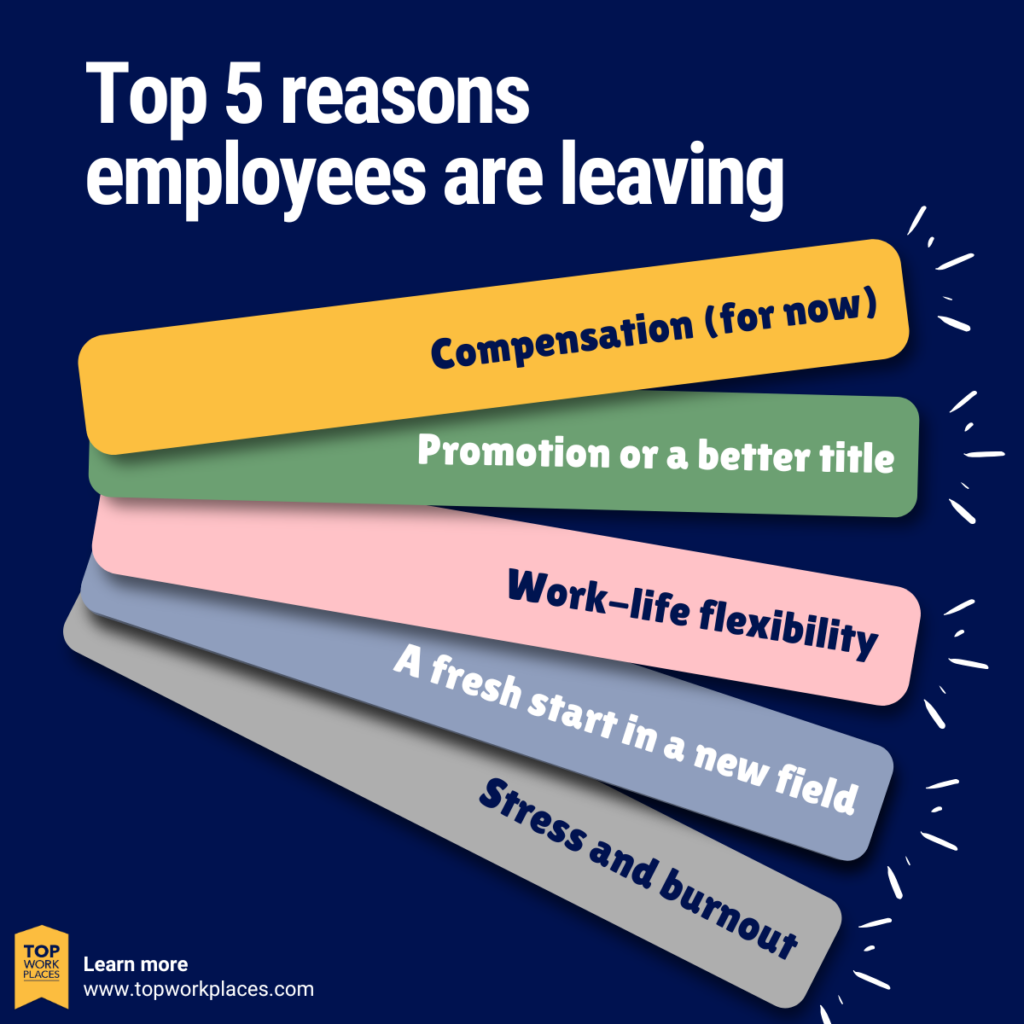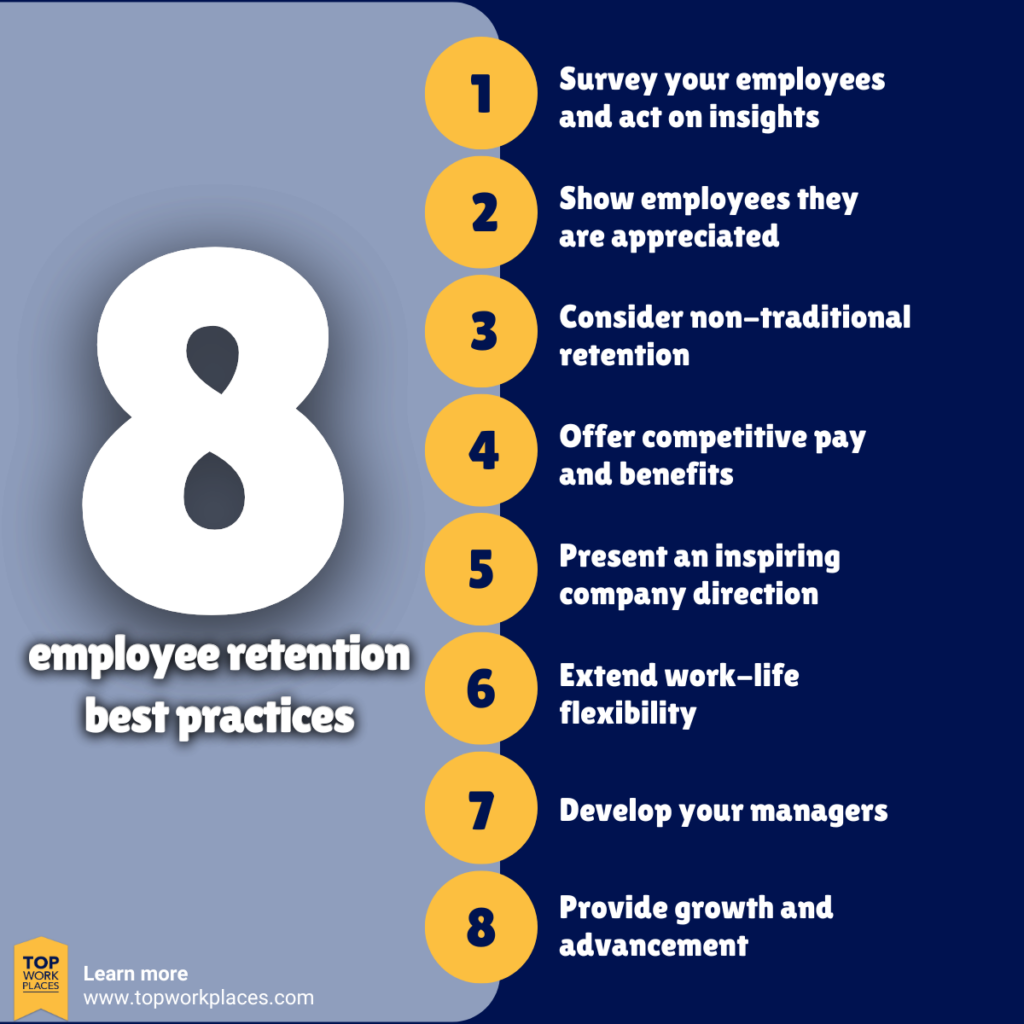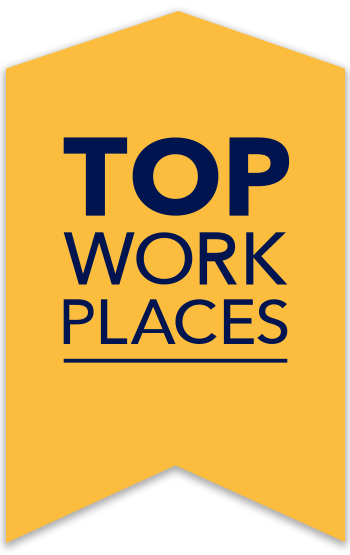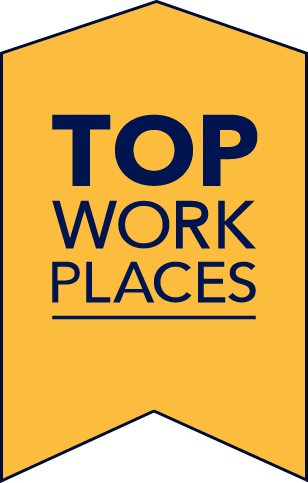“Are you worried about employee retention?”
It’s not a question that needs to be asked. Your best employees are walking out the door, and there is an increasing stream of resignation emails in your inbox. Employee turnover is real, and it’s hitting hard.
With more than one in three employees actively looking for new opportunities, the pressure is on. It’s not a matter of if turnover is coming — it’s whether you can stop it before it’s too late.
In this post, we’ll explore the top reasons employees are leaving and what you can do to keep your talent before it’s too late. You’ll walk away with practical strategies that can help you retain top talent people and create a workplace culture that makes them want to stay.
Retention is a big concern, but action is lacking
A recent Top Workplaces Research Lab study shows 88% of employers are trying to reduce employee turnover. But here’s the thing: While many say they are worried, fewer are taking the right steps to keep their people around. As employee turnover rates climb, the pressure on HR to fix it is higher than ever.
Employee retention isn’t about holding onto warm bodies; it’s about keeping the right people — the folks who truly align with your company’s mission and values. If employees don’t feel like they’re part of something bigger, if they don’t feel valued or invested, they’ll start looking for their next opportunity.
Top 5 reasons employees are leaving
There are a lot of reasons employees decide to leave, and while some might be obvious, others can catch you off guard. From compensation to burnout, here’s a breakdown of the top factors driving your best people to start looking elsewhere — and what you can do about it.

Compensation is a top factor, for now
While work-life balance and career growth matter, pay is getting more attention these days, especially with the economy feeling unstable. Employees might not always jump ship for a bigger paycheck, but if they feel their salary isn’t keeping up with their skills, experience, or the market, they’re more likely to start looking around. To keep your top talent, it’s important to make sure your pay structure stays competitive and fair, so you’re not losing people over something that’s easily fixable.
Promotion or a better title
Career growth plays a huge role in whether employees stick around. No one wants to feel like they’re stuck in the same role forever. If employees don’t see a way to move up or grow, they’ll start looking for a company that offers a clear path forward. Providing opportunities for professional development, promoting from within, and offering leadership training are great ways to keep your team engaged and motivated, so they’re less likely to leave.
The growing need for work-life-flexibility
These days, employees are putting more emphasis on balancing work and personal life. Flexibility with work hours, remote options, and the ability to adjust schedules when needed are more important than ever. If your company isn’t offering these kinds of flexible work options, you might find your best people looking elsewhere for a job that lets them have that freedom.
Some want a fresh start in a new field
Whether it’s due to burnout or a desire for new challenges, some are seeking a change in industries. For HR leaders, this means keeping a pulse on what employees value and offering them meaningful projects or roles that align with their interests.
Stress and burnout are real
When employees are constantly swamped with work, especially in high-pressure jobs, burnout is a real risk. Whether it’s because of being short-staffed or having unrealistic expectations, too much on their plate can lead to frustration and disengagement. Keeping workload balance in check is key to holding onto your team. Encouraging managers to check in regularly and make sure work is spread evenly can help prevent burnout and keep everyone happier and more productive.
8 employee retention best practices
To keep your top talent and reduce employee turnover, you need a workplace experience that makes people feel valued and excited to stay. These best practices will help you create an environment where employees are engaged, motivated, and ready to stick around for the long haul.

1. Survey your employees and act on insights
Employee feedback is gold when it comes to understanding why people might be looking for something new. Don’t just skim the surface — dig into both the positive and constructive comments to get the full picture. What’s working well? What needs improvement? Listening and acting on this feedback shows your team that you’re not just paying lip service to their concerns. It helps you keep the right people and fix the things that matter most.
Learn more: Communicating Survey Results
2. Show employees they're appreciated
No one likes to feel invisible. If you want to keep people, make sure they know their hard work doesn’t go unnoticed. Thank employees for hitting milestones, crushing their goals, and especially for going above and beyond. A little recognition goes a long way in making people feel valued and invested in staying with the company.
Learn more: 15 Workplace Appreciation Ideas
3. Consider non-traditional retention
Employees may leave for reasons outside of the job, like retirement, school, or family changes. Instead of losing them, think outside the box. Can you offer flexible hours, job sharing, or even reduced schedules? Work with employees to find ways to keep them around, even if it means adjusting the role to fit new circumstances.
4. Offer competitive pay and benefits
In today’s world of rising costs for housing, healthcare, food, and more, employees can’t afford to let compensation take a backseat, so organizations can’t either. Ensure you are providing competitive compensation packages, particularly to the employees it would be most costly to lose.
5. Present an inspiring company direction
Employees want to be a part of something bigger. If your company’s direction excites and inspires them, they’ll want to stick around and help make it happen. Share your vision, talk about where the company is headed, and make sure it’s compelling enough for your employees to feel connected to the future you’re building together.
Learn more: Why Confidence in Leadership Matters
6. Extend workplace flexibility
Work-life balance is something employees want. Offering more flexibility with where and when employees work helps them balance their personal lives and be productive at the same time. If you impose unnecessary rigidity, you may find that an employee struggling to make a strict starting time due to family obligations might be more inclined to entertain recruiters’ calls.
7. Develop your managers
You’ve probably heard it before: Employees don’t leave companies, they leave managers. Even though that’s not always the case, managers have a huge impact on retention. Investing in leadership and people skills for your managers helps them build strong, supportive relationships with their teams. A good manager can make all the difference in whether someone stays or goes.
8. Provide growth and advancement
People don’t want to hit a dead-end. They want to keep learning, growing, and advancing. If your employees don’t see a future with your company, they’ll start looking for one elsewhere. Make sure there are opportunities for learning and internal promotions so employees can see a clear path for their development and growth within the organization.
Are your employees looking for new job opportunities?
Participating in Top Workplaces will help you find out. Based on confidential employee feedback, Top Workplaces begins with an employee engagement survey that identifies your organizations strengths and pain points. Not to mention, employees who feel valued and heard are more likely to stick around.
Start participation here by nominating your company below. There’s no cost to participate, survey your employees, or win awards. And with just one survey, you can unlock eligibility for dozens of award opportunities.

 Stand out with an award-winning
Stand out with an award-winning